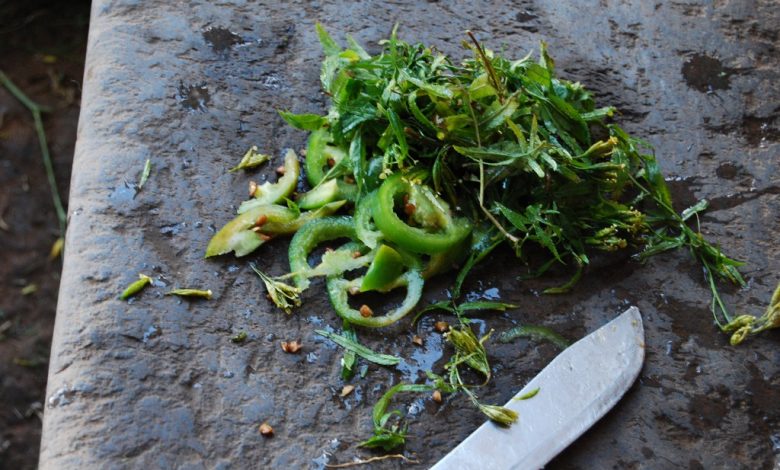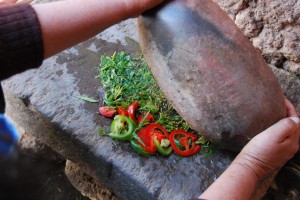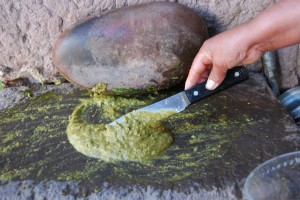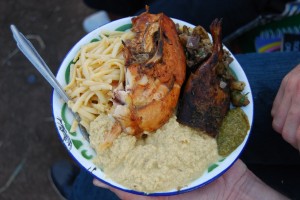Llantán, Cuzco’s Hot Sauce

Peru is a land with a rich variety of hot sauces made from its rainbow of ají peppers and herbs. To travel from town to town, or even restaurant to restaurant in a place like Cuzco, is to experience a revelation of flavors that add just the right zest to your food.
Since many restaurants for tourists and locals have abandoned this tradition in favor of the industrial bottle of imported vinegary heat called Tabasco, at Cuzco Eats we shall describe these other sauces that still live in Cuzco’s restaurants and homes. They are well worth tasting.
Perhaps the most common sauce in Cuzco is called llantán and is made from hot peppers and the important Peruvian herb of Inca origins called huacatay (also spelled wacatay or wakatay.)
Celebrity Chef Coque Ossio chose to use a version of llantán in his outstanding restaurant Limo. He serves it with specialty french fries from fine Peruvian potatoes as an appetizer. The aroma of the huacatay, both minty and earthy, along with the zing of the hot peppers make the fries’ flavor come alive.
Indeed llantán is a symphony of a sauce. The hot peppers are the background, a rumbling of bass notes that occasionally takes on the brio of high overtones, while the huacatay is a melody that moves from one section to another, from the violins to the clarinets to the violas of its complex flavor profile.


In Cuzco, llantán generally replaces the green, cilantro based sauce common in the creole cooking of Peru´s coast. Like the highlands, it has a stronger and sharper flavor than the cilantro sauce, good though the latter is. The difference is like the thunder and romance of Rachmaninov in comparison to the very fine, but thin, works of the classical Salieri. Some days the lightness of Salieri or cilantro is perfect, but other days require the roiling weight of Rachmaninov and llantán.
Different cooks will arrange it differently, like a conductor who can change the tempo or call for more or less from each instrument. And some will even add a new ingredient to the orchestration. But the crux of llantán’s score is simple: huacatay and hot peppers ground together into a fine paste.
Online one can find several versions of llantán from Arequipa which, though a larger city, has been very influenced by the culture of Cuzco. The two cities have many things in common and a long, very long, historical relationship.
In these it is common to add onion and perhaps garlic to weaken and tame the wildness of huacatay’s flavors for a more citified palate unaccustomed to the strong flavors of the highlands.
Furthermore, the peppers and onions are cooked, whether in an oven or pan on the stove top. Sometimes a little cheese is added, and sometimes the huacatay itself is tamed by becoming part of a trio of parsley cilantro and huacatay.
These make good sauces. But they lack the strength, and the depth, of the straight llantán we saw made in Cuzco.
The day that Doña Mercedes’ mother celebrated her eighty-fourth birthday, Doña Mercedes and her sister-in-law prepared a meal built around a dualism: roast chicken thighs and roast guinea pig. For that meat with its crispy skin and deep, roasted flavor, Doña Mercedes made a llantán.
She first sliced a green hot pepper, seeds and all, onto her grinding stone base, her batán. To this she added a healthy mound of huacatay leaves roughly broken apart. Then she sliced a red hot pepper, a rocoto, adding it to her pile black seeds and all.
She lifted the heavy curved grinding stone and rocked it back and forth on the pile producing a roughly ground paste that had not yet attained a consistency.

With her knife she scraped this from the base into another, much more concentrated pile to which she added soaked bread.
Then she started working, while sitting on a low stool against the stone base on which she worked. Rocking the other stone back and forth as if it were a cradle she kept at it until the sauce came together with a consistency and texture that she liked.
Once it had arrived at that point she added salt and rocked her grinding stone over the sauce some more.
Now she lifted the finished sauce on the back of her knife and placed it in a bowl. Once everyone had been served their plates mounded high with the meat and its accompaniments, Doña Mercedes passed around the bowl of llantán for each of us to add to our plate as we wished.
It was a perfect companion fro the smokiness of the roasted meat.

In Cuzco you can ask for llantán. Or if you are at home you can try making it, either in the version from Arequipa or by following Doña Mercede model.
Ok, I know almost no kitchens in the US or Europe, not even Australlia or Israel, come with a wide, flat stone base for grinding. Nor do people have the curved upper stone to rock things into a paste. But kitchens generally do have food processors that through pulsing the ingredients can produce a reasonable facsimile.
Also, people do not generally have huacatay growing in their back yards, like Doña Mercedes’ brother does. So you will have to get it either bottled or frozen through a local Latin American store or online.
All you have to do is figure out the balance you want between the peppers and the huacatay. Once you have that down, you will have a sauce that will give you a very different but enticing taste and will transport you to the remnants of Inca Peru.





Greetings from Colorado! I’m bored at work so I decided to
browse your website on my iphone during lunch break. I enjoy the information you present here and can’t
wait to take a look when I get home. I’m shocked at how quick your blog loaded on my phone
.. I’m not even using WIFI, just 3G .. Anyways, awesome blog!
Thank you. We work hard and are happy you enjoy our page. That is an honor. May it continue to delight you.
David
Howdy! Do you use Twitter? I’d like to follow you if that would be ok.
I’m undoubtedly enjoying your blog and look forward to new updates.
We were using twitter but have just undergone a major reworking of the page and expect to get back to Twitter very soon. We look forward to your following us and to your comments on things you like or things that may need improvement.